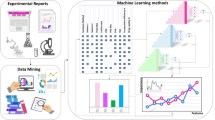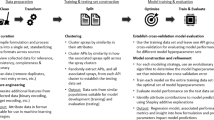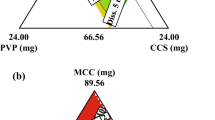Abstract
Engineering pharmaceutical formulations is governed by a number of variables, and the finding of the optimal preparation is intricately linked to the exploration of a multiparametric space through a variety of optimization tasks. As a result, making such optimization activities simpler is a significant undertaking. For the purposes of this study, we suggested a prediction model that was based on least square support vector machine (LSSVM) and whose parameters were optimized using the particle swarm optimization algorithm (PSO-LSSVM model). Other in silico optimization methods were used and compared, including the LSSVM and the back propagation (BP) neural networks algorithm. PSO-LSSVM demonstrated the highest performance on the test dataset, with the lowest mean square error. In addition, two dosage forms, quercetin solid dispersion and apigenin nanoparticles, were selected as model formulations due to the wide range of formulation compositions and manufacturing factors used in their production. Three different models were used to predict the ideal formulations of two different dosage forms, and in real world, the Taguchi orthogonal design arrays were used to optimize the formulations of each dosage form. It is clear that the predicted performance of two formulations using PSO-LSSVM was both consistent with the outcomes of the Taguchi orthogonal planned experiment, demonstrating the model’s good reliability and high usefulness. Together, our PSO-LSSVM prediction model has the potential to accurately predict the best possible formulations, reduce the reliance on experimental effort, accelerate the process of formulation design, and provide a low-cost solution to drug preparation optimization.






Similar content being viewed by others
Abbreviations
- OFAT:
-
One-factor-at-a-time method
- DoE:
-
Design of experiment
- RSM:
-
Response surface methodology
- LSSVM:
-
Least square support vector machines
- BP:
-
Back propagation neural networks algorithm
- PSO:
-
Particle swarm optimization algorithm
- PSO-LSSVM:
-
LSSVM optimized by the particle swarm optimization algorithm
- ANOVA:
-
Analysis of variance
- PVPK30:
-
Polyvinylpyrrolidone K30
- MSE:
-
The mean square error
References
Czitrom V. One-factor-at-a-time versus designed experiments. Am Stat. 1999;53(2):126–31. https://doi.org/10.1080/00031305.1999.10474445.
Zhang L, Mao S. Application of quality by design in the current drug development. Asian J Pharm Sci. 2017;12(1):1–8. https://doi.org/10.1016/j.ajps.2016.07.006.
Buttini F, Rozou S, Rossi A, Zoumpliou V, Rekkas DM. The application of quality by design framework in the pharmaceutical development of dry powder inhalers. Eur J Pharm Sci. 2018;113:64–76. https://doi.org/10.1016/j.ejps.2017.10.042.
Wang S, Wen H, Li P, Cui M, Sun W, Wang H, Liu H, Li S, Pan W, Yang X. Formulation and evaluation of gastric-floating controlled release tablets of Ginkgolides. J Drug Deliv Sci Technol. 2019;51:7–17. https://doi.org/10.1016/j.jddst.2019.02.011.
Fan W, Zhu W, Zhang X, Di L. The preparation of curcumin sustained-release solid dispersion by hot melt extrusion-I. Optimization of the Formulation. J Pharm Sci. 2020;109(3):1242–52. https://doi.org/10.1016/j.xphs.2019.11.019.
Mendonsa NS, Pradhan A, Sharma P, Prado RMB, Murthy SN, Kundu S, Repka MA. A quality by design approach to develop topical creams via hot-melt extrusion technology. Eur J Pharm Sci. 2019;136:104948. https://doi.org/10.1016/j.ejps.2019.06.002.
Zhu J, Wang Q, Li H, Zhang H, Zhu Y, Omari-Siaw E, Sun C, Wei Q, Deng W, Yu J, Xu X. Galangin-loaded, liver targeting liposomes: optimization and hepatoprotective efficacy. J Drug Deliv Sci Technol. 2018;46:339–47. https://doi.org/10.1016/j.jddst.2018.05.034.
Mohammadpour F, Hadizadeh F, Tafaghodi M, Sadri K, Mohammadpour AH, Kalani MR, Gholami L, Mahmoudi A, Chamani J. Preparation, in vitro and in vivo evaluation of PLGA/Chitosan based nano-complex as a novel insulin delivery formulation. Int J Pharm. 2019;572:118710. https://doi.org/10.1016/j.ijpharm.2019.118710.
Mendyk A, Jachowicz R. Neural network as a decision support system in the development of pharmaceutical formulation—focus on solid dispersions. Expert Syst Appl. 2005;28(2):285–94. https://doi.org/10.1016/j.eswa.2004.10.007.
Metwally AA, Hathout RM. Computer-assisted drug formulation design: novel approach in drug delivery. Mol Pharm. 2015;12(8):2800–10. https://doi.org/10.1021/mp500740d.
Zhao F, Lu J, Jin X, Wang Z, Sun Y, Gao D, Li X, Liu R. Comparison of response surface methodology and artificial neural network to optimize novel ophthalmic flexible nano-liposomes: Characterization, evaluation, in vivo pharmacokinetics and molecular dynamics simulation. Colloids Surf B: Biointerfaces. 2018;172:288–97. https://doi.org/10.1016/j.colsurfb.2018.08.046.
Ghasemi F, Mehridehnavi A, Pérez-Garrido A, Pérez-Sánchez H. Neural network and deep-learning algorithms used in QSAR studies: merits and drawbacks. Drug Discov Today. 2018;23(10):1784–90. https://doi.org/10.1016/j.drudis.2018.06.016.
Van Gestel T, Suykens JA, Lanckriet G, Lambrechts A, De Moor B, Vandewalle J. Bayesian framework for least-squares support vector machine classifiers, gaussian processes, and kernel Fisher discriminant analysis. Neural Comput. 2002;14(5):1115–47. https://doi.org/10.1162/089976602753633411.
Yamagami T, Jiang J-C. A search for the critical slip surface in three-dimensional slope stability analysis. Soils Found. 1997;37(3):1–16. https://doi.org/10.3208/sandf.37.3_1.
Das S, Abraham A, Konar A. Particle swarm optimization and differential evolution algorithms: technical analysis, applications and hybridization perspectives. In: Liu Y, Sun A, Loh HT, Lu WF, Lim E-P, editors. Advances of computational intelligence in industrial systems. Berlin, Heidelberg: Springer Berlin Heidelberg; 2008. p. 1-38.
Sain SR. The Nature of Statistical Learning Theory. In: The nature of statistical learning theory: Taylor & Francis; 1996.
Suykens JA, Vandewalle J. Least squares support vector machine classifiers. Neural Process Lett. 1999;9(3):293–300.
Pelckmans K, Suykens JA, Van Gestel T, De Brabanter J, Lukas L, Hamers B et al. LS-SVMlab: a matlab/c toolbox for least squares support vector machines. Tutorial KULeuven-ESAT Leuven, Belgium. 2002;142(1-2).
Fan R-E, Chen P-H, Lin C-J, Joachims T. Working set selection using second order information for training support vector machines. Journal of machine learning research. 2005;6(12).
Chang C-C, Lin C-J. LIBSVM: a library for support vector machines. ACM Trans Intell Syst Technol. 2011;2(3):Article 27. doi: 10.1145/1961189.1961199.
Hsu C-W, Chang C-C, Lin C-J. A practical guide to support vector classification. 2016.
MathWorks I. MATLAB and statistics toolbox release. MA: Author Natick; 2012.
Abdulkadir R, Imam KA, Jibril M. Simulation of back propagation neural network for iris flower classification. Am J Eng Res. 2017;6(1):200–5.
Wanto A, Windarto AP, Hartama D, Parlina I. Use of binary sigmoid function and linear identity in artificial neural networks for forecasting population density. IJISTECH Int J Inform Syst Technol. 2017;1(1):43–54.
Zhao Z, Xin H, Ren Y, Guo X, editors. Application and comparison of BP neural network algorithm in MATLAB. 2010 International Conference on Measuring Technology and Mechatronics Automation; 2010 13-14 March 2010.
Bai Q. Analysis of particle swarm optimization algorithm. Comput Inform Sci. 2010;3(1):180.
Wang D, Tan D, Liu L. Particle swarm optimization algorithm: an overview. Soft Comput. 2018;22(2):387–408.
Yang X-S. Chapter 8—particle swarm optimization. In: Yang X-S, editor. Nature-inspired optimization algorithms (Second Edition). Acad Press; 2021. p. 111-121, Particle Swarm Optimization.
Allen DM. Mean square error of prediction as a criterion for selecting variables. Technometrics. 1971;13(3):469–75.
Montgomery DC, Peck EA. Vining GG. Introduction to linear regression analysis: John Wiley & Sons; 2021.
Tawfeek HM, Chavan T, Kunda NK. Effect of spray drying on amorphization of indomethacin nicotinamide cocrystals; optimization, characterization, and stability study. AAPS PharmSciTech. 2020;21(5):181. https://doi.org/10.1208/s12249-020-01732-x.
Panigrahi KC, Patra CN, Rao MEB. Quality by design enabled development of oral self-nanoemulsifying drug delivery system of a novel calcimimetic cinacalcet HCl using a porous carrier: in vitro and in vivo characterisation. AAPS PharmSciTech. 2019;20(5):216. https://doi.org/10.1208/s12249-019-1411-2.
Sharma M, Sharma G, Singh B, Katare OP. Systematically optimized imiquimod-loaded novel hybrid vesicles by employing design of experiment (DoE) approach with improved biocompatibility, stability, and dermatokinetic profile. AAPS PharmSciTech. 2019;20(4):156. https://doi.org/10.1208/s12249-019-1331-1.
He Y, Ye Z, Liu X, Wei Z, Qiu F, Li H-F, Zheng Y, Ouyang D. Can machine learning predict drug nanocrystals? J Control Release. 2020;322:274–85. https://doi.org/10.1016/j.jconrel.2020.03.043.
Elbadawi M, Muniz Castro B, Gavins FKH, Ong JJ, Gaisford S, Perez G, et al. M3DISEEN: a novel machine learning approach for predicting the 3D printability of medicines. Int J Pharm. 2020;590:119837. https://doi.org/10.1016/j.ijpharm.2020.119837.
Gao H, Ye Z, Dong J, Gao H, Yu H, Li H, Ouyang D. Predicting drug/phospholipid complexation by the lightGBM method. Chem Phys Lett. 2020;747:137354. https://doi.org/10.1016/j.cplett.2020.137354.
Acknowledgements
This work was supported, in part, by the National Natural Science Foundation of China (No. 82074286), Natural Science Foundation of Jiangsu Province (Nos. BK20191428, BK20181445), Six Talent Peak Project from Government of Jiangsu Province (No. SWYY-013), and the Scientific Research Foundation of Jiangsu University (No. 12JDG034, 14JDG163).
Author information
Authors and Affiliations
Contributions
S. W and J. Y contribute to the conception of the work. H. C, K. C, X. Y, Y. W, and H. Z conducted the work. And H. C, and K. C analyzed the data for the work. M. R and C. F approved the version to be published.
Corresponding authors
Ethics declarations
Conflict of Interest
The authors report no conflicts of interest. The authors alone are responsible for the content and writing of this article.
Additional information
Publisher’s Note
Springer Nature remains neutral with regard to jurisdictional claims in published maps and institutional affiliations.
Rights and permissions
About this article
Cite this article
Wang, S., Yang, J., Chen, H. et al. A Strategy for the Effective Optimization of Pharmaceutical Formulations Based on Parameter-Optimized Support Vector Machine Model. AAPS PharmSciTech 23, 66 (2022). https://doi.org/10.1208/s12249-022-02210-2
Received:
Accepted:
Published:
DOI: https://doi.org/10.1208/s12249-022-02210-2




